Supreme Court Strikes Down Abortion Clinic Buffer Zones
Another solid victory for the First Amendment from the Roberts Court.
In a surprisingly unanimous decision, the Supreme Court has struck down a Massachusetts law that prohibit protests from a zone within 35 feet of an abortion clinic, even if that zone included public property:
WASHINGTON — The Supreme Court on Thursday unanimously struck down a Massachusetts law that barred protests near abortion clinics.
The law, enacted in 2007, created 35-foot buffer zones around entrances to abortion clinics. State officials said the law was a response to a history of harassment and violence at abortion clinics in Massachusetts, including a shooting rampage at two facilities in 1994.
The law was challenged on First Amendment grounds by opponents of abortion who said they sought to have quiet conversations with women entering clinics to tell them about alternatives to abortion.
The court was unanimous about the bottom line but divided on the reasoning. Chief Justice John G. Roberts Jr. wrote a relatively narrow majority opinion. He was joined by Justice Ruth Bader Ginsburg, Stephen G. Breyer, Sonia Sotomayor and Elena Kagan. He suggested that the state could pursue other alternatives.
Justice Antonin Scalia, in a concurrence joined by Justices Anthony M. Kennedy and Clarence Thomas, said the majority’s approach was too tentative. The law, he said, is “unconstitutional root and branch.”
Justice Samuel A. Alito Jr. filed a separate concurrence.
In 2000, the Supreme Court upheld a similar Colorado law in Hill v. Colorado. That law established 100-foot buffer zones outside all health care facilities, not just abortion clinics. Inside those larger zones, the law banned approaching others within eight feet for protest, education or counseling without their consent.
Massachusetts experimented with a similar law but found it inadequate.
In testimony before a legislative committee in 2007, Capt. William B. Evans, then a police commander and now Boston’s police commissioner, said the floating-bubble approach made his officers’ job impossible. “I like to make the reference of a basketball referee down there, where we’re watching feet, we’re watching hands,” he said.
The 2007 law at issue in the case, McCullen v. Coakley, No. 12-1168, did away with floating bubbles and the need to determine who approached whom and whether the listener consented. Instead, it bars everyone from entering or staying in fixed buffer zones around entrances to reproductive health care facilities.
Lyle Denniston analyzes:
The lead opinion by Chief Justice John G. Roberts, Jr., in McCullen v. Coakley went to considerable lengths to suggest ways that cities or states could pass new laws to protect patients’ access to abortion facilities. But all of those approaches, it appeared, would be to thwart actual obstruction, physical intrusion, or actual intimidation of patients, not the kind of “counseling” that the Court found threatened by the Massachusetts law.
What the First Amendment does protect, the Roberts opinion made clear, is gentle persuasion, at least when that is carried out on the public sidewalks and roadways next to an abortion facility. Citing data by abortion foes who insist they engage only in benign counseling, the Chief Justice said they have had “far less frequent and far less success” in getting even to talk to patients personally or hand them literature since the buffer zone was imposed.
“It is no answer,” the Chief Justice wrote, “to say that [abortion counselors] can be seen and heard by women within the buffer zones. If all that the women can see and hear are vociferous opponents of abortion, then the buffer zones have effectively stifled [the] message [of counseling].”
Concluding that sidewalk counselors working the sidewalks around abortion clinics are “not protestors,” the Court’s main opinion said that “they seek only to inform women of various alternatives and to provide help in pursing them. [They] believe that they can accomplish this objective only through personal, caring, consensual conversations.”
The opinion thus put state and city governments on notice that, while they may act to ensure public safety around and abortion patients’ access to medical facilities providing such services, they cannot do so by making entirely off limits to counselors the areas closest to the clinics that include public sidewalks and roadways.
This, then, was a ruling about “buffer zones.” The Court’s main opinion did not consider the continuing validity of a prior case about anti-abortion protests, dealing with the somewhat separate issue of “bubble zones.” In its decision in 2000 in Hill v. Colorado, the Court had upheld a state law that limited close contact with persons entering or leaving an abortion clinic, by setting up a “buffer zone” and, within that zone, making it illegal to approach a person closer than eight feet (a “bubble zone”) without that person’s consent, to engage in counseling or literature distribution.
After this new ruling, it appeared that even a “bubble zone” might be vulnerable to challenge, at least when the patient was shielded from counseling on a public sidewalk or roadway near the clinic. The Chief Justice’s approving remarks about the First Amendment right to engage in counseling in public arenas appeared to contradict some of the reasoning of the 2000 decision.
In a future test case on “bubble zones,” it would appear that four Justices who on Thursday wanted to strike down the Massachusetts law on broader grounds than those used by the Chief Justice might well be prepared to vote to strike down a “bubble zone.” In fact, three of those four Justices called specifically on Thursday for overruling of the Hill v. Colorado precedent. Those three were Justice Antonin Scalia, the author of a separate opinion, joined by Justices Anthony M. Kennedy and Clarence Thomas.
Eugene Volokh comments on the opinion:
The majority (Chief Justice Roberts, joined by the four more liberal Justices, Justices Ginsburg, Breyer, Sotomayor, and Kagan) interpreted exception (2) as not allowing advocacy by clinic employees or agents, and thus concluded that this exception doesn’t make the law content- or viewpoint-based. And the majority also concluded that the fact the law was limited to abortion clinics doesn’t make it content-based: The law doesn’t draw any content distinctions on its face, didn’t “require[] ‘enforcement authorities’ to ‘examine the content of the message that is conveyed to determine whether’ a violation has occurred,” and was justified by concerns unrelated to the content of speech — concerns about “public safety, patient access to healthcare, and the unobstructed use of public sidewalks and roadways.”
Nonetheless, the majority held, the law is unconstitutionally overinclusive even though it is content-neutral. It bars communication in a traditional public forum (public sidewalks), including face-to-face conversation (and not just shouting across many yards) that is important to persuasion, and it does so even in many situations where there is no material threat of violence, congestion, obstruction, and the like. The government had many alternatives to these 35-foot-radius buffer zones, such as banning instances of obstruction, violence, or threat of violence, or even issuing injunctions following specific findings that a person or group has engaged in such misbehavior and less burdensome means for preventing misbehavior would likely ber ineffective. And the government hadn’t shown that such alternatives would do a poor job of protecting safety and clinic access.
To be sure, the majority said, the alternatives might be harder for the government to implement and enforce than a simple buffer zone — but that, the majority said, wasn’t enough
As a general rule, the Court has been very careful in examining laws that purport to regulate the manner in which people protest in public. The case law in this area has established the general rule that the regulations can only relate to the time, place and manner of the protests, that they must be content neutral, and that the regulations must be narrowly tailored to meet the governmental interest asserted. In this case, Chief Justice Roberts held for a unanimous court, that the Massachusetts law failed because it was not narrowly tailed to meet the interest asserted because it places too stringent a burden on speech.
Tara Culp-Essler at Think Progress seems to see this as an attack on women’s abortion rights:
Reproductive rights advocates had been hoping the justices would uphold the policy, which they say has gone a long way to ensure that woman can safely enter abortion clinics. More than 30 pro-choice organizations filed an amicus brief urging the Supreme Court to rule in favor of Massachusetts’ buffer zone, which was approved in response to a mass shooting at several of the state’s abortion clinics.
According to the National Abortion Federation (NAF), which closely tracks threats and violence against abortion providers across the country, buffer zones have had a measurable impact in the areas where they’re in place. A recent survey conducted among NAF’s member organizations found that 51 percent of facilities in areas with buffer zones reported a decrease in criminal facility after the policy was enacted, and 75 percent of them said it helped improve patients’ and staff members’ ability to access the clinic.
“Buffer zones make a huge difference,” Ashley Hartman, who holds a master’s in public health from Ohio State University and has volunteered as a clinic escort in the Cleveland area, said in an interview with ThinkProgress. “The reality is, if you’ve ever been outside a clinic, it’s not about exchanging ideas… Protesting is about creating the feeling of intimidation, so the more distance you can have from them, the less powerful that intimidation is.”
Now that the policy has been struck down, however, the women visiting reproductive health facilities in Massachusetts won’t be able to rely on that distance. Protesters will be allowed to crowd the sidewalks around the clinic and speak directly to patients — something that can make people feel uncomfortable enough to avoid the clinic and skip out on the health services they need.
“The fact that we even have clinic escorts is a good signifier that we need things like buffer zones,” Hartman pointed out. Clinic escorts like her are typically responsible for providing a friendly face to women who are nervous to walk past protesters, often working to distract them from what abortion opponents are shouting at them. “We wouldn’t need escorts if walking into a clinic didn’t involve that type of harassment.”
Thursday’s decision may put other areas’ buffer zones in jeopardy, too. Now that Massachusetts’ policy has been invalidated, it could pave the way for opponents to strike down similar laws on similar grounds. In practical terms, that means it’s probably about to get harder for many women to access clinics.
Culp-Essler’s mistake her is that she immediately puts this case in the “abortion” category before she even starts to analyze. The Court makes clear that this is not a case about abortion or abortion rights, it is a case about what if any regulations a jurisdiction can enact to restrict people’s rights under the First Amendment. Indeed, this decision is consistent with much of the First Amendment jurisprudence that we’ve seen from the Roberts Court in recent years. Most notably in Snyder v. Phelps, in which the Court struck down a civil judgment against the Westboro Baptist Church related to its protests at funerals, the Court has made it clear that the fact that speech is offensive or aggressive is not sufficient reason to ban or punish people for engaging in it. Indeed, one could make the argument that the Roberts Court is developing a reputation for being one of the strongest protectors of First Amendment rights since the Warren Court era, perhaps even more so given that so many of their opinions in this area have been unanimous or near unanimous. Given the subject matter of the case here one could have reasonably expected that we’d see more of an ideological breakdown such as that which we’d see in a case actually dealing with abortion rights, but it’s obvious that the Court viewed this case as a Freedom of Speech case, not an abortion case, and that made all the difference.
Here’s the opinion:
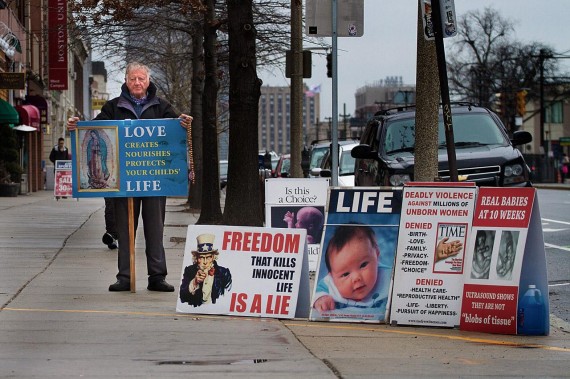

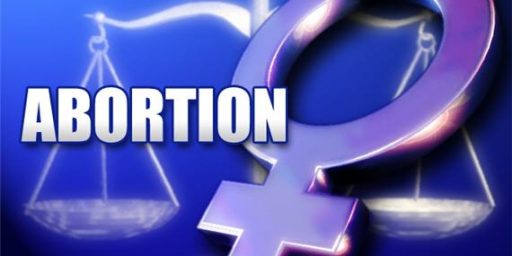
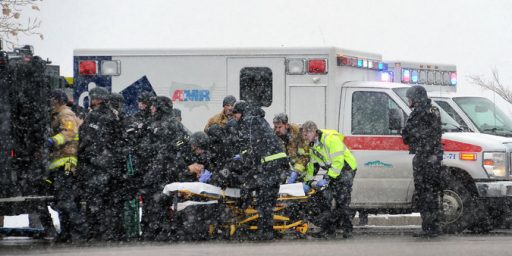
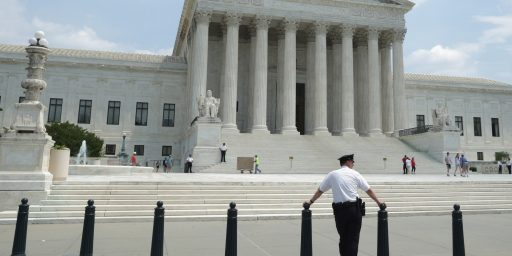
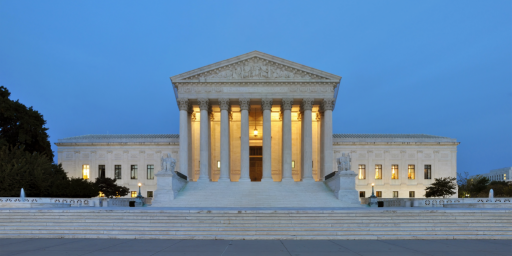
Problem with your title. They only struck down 1 Buffer Zone and made a particular point that it was exceptional among the various ones in play – and that the rest would be fine. It was the 4 member concurrence that would have struck them all down and the Majority disagreed.
Roberts is either extremely gullible, or is insulting our intelligence. Anyone who has ever walked into a Planned Parenthood will tell you that there is absolutely no calm, benign, gentle persuasion being attempted. Period, full stop. There IS shouting, hurling vile epithets (whore, murderer, etc), and any other action they can think of to intimidate women. I’ve seen it many many times myself, including at the exact Boston PP where the incidents occurred that necessitated this law (my wife used to get her birth control at PP because it was cheaper than going through her doctor).
Doug…
Are you able to explain the private property piece of this?
If I own a clinic and it’s say 35′ from the public right of way…do these zealots have the right to trespass in order to harass my patients??? I mean…if I own a business open to the public anyone can enter the property…but I can regulate their behavior, correct?
Since when does your First Amendment right to want to talk to me override my First Amendment right to not want to talk to or deal with your crazy self? Much like the creeper guy on the bus who “just wants to complement your dress” when you’re trying to read and they’re bothering you, why does the protesters’ need to impose and “talk” to someone override the visitor’s clear desire to not speak with them (otherwise, they’d be over there chatting!)?
Sounds like forced association – making sure the protestors have association rights and access that the visitor does not want nor agree to.
I’d love to see what’s going to happen now in Stand Your Ground states. Someone comes towards me screaming SLUT and MURDERER….well, I think I’d have a pretty good defense, no?
@C. Clavin:
That would be trespassing, but that’s generally not what happens in these situations. These protesters do tend to stay on public property, indeed they seem to be very careful not to stray onto the actual property of the clinic
@Ben:
It’s important to note that this isn’t *Roberts alone*, its Roberts writing for the members of the court who joined in this decision: Justice Ruth Bader Ginsburg, Stephen G. Breyer, Sonia Sotomayor and Elena Kagan (i.e. the entire Liberal wing). So if Roberts is gullible, then you need to extend it to all of the signatories as well.
@Doug Mataconis: Serious question Doug. What if the benign, kindly, sidewalk councilor approaches a woman, and the woman refuses to talk to her, and the councilor is not willing to step aside? What recourse does the woman have?
@humanoid.panda:
Then you’re talking about assault, and possibly battery.
@Matt Bernius:
Indeed, the fact that Ruth Bader Ginsburg, who founded the women’s rights law center of the ACLU, was in the majority suggests to me that the people trying to turn this into an abortion case rather than a First Amendment case need to step back and think for a minute.
Actually, Tara Culp-Essler has it exactly right, and you’re the one who’s wrong. Anyone who has actually seen clinic protestors in action understands that they aren’t there to benignly exercize their constitutionally protected rights (to free speech); they are there to actively prevent other people from exercizing their constitutionally protected rights (to terminate a pregnancy).
That SCOTUS unanimously failed to understand this just speaks to how out of touch with real life even the liberals on the court are.
Couple points — as I understand the ruling (and I only scanned it + read some coverage) — it doesn’t completely shut the door on buffer zones entirely. It simply objected the the *blanket* buffer zone application. It seems like it leaves the opportunity for certain providers to get special buffer zones established if they can prove the need for them (as in the particular Boston clinic that inspired the ruling in the first place).
Further, I think it’s worth revisiting part of the analysis:
While it’s not perfect, I think it’s worth noting that digital recording technologies have advanced to such a point where it’s far easier to document protest abuses and get restraining orders against groups or individuals who violate the misbehavior. The unfortunate part, without a doubt, is that this still requires someone to first be *victimized.”
Accepting that (which, is admittedly difficult to accept), the Clinics and Patients have a far greater range of tools at their disposal today than when this particular law was first enacted.
I would think that this ruling would put the buffer zone that exists at the Supreme Court itself in jeopardy of being unconstitutional.
@Ben: Gee… almost like the protest lines outside the Tea Party meetings, huh?
(snort)
The most worrisome parts are the continuing series of 5-4 splits on reasoning that helps predictability (and stability) not a whit, and the fact that in this and the recess appointments case this week, amongst others, there’s just one vote preventing a reactionary overturning of nearly all the tables in the temple.
@Matt Bernius:
Kind of like not being able to lock up criminals until they, you know, commit a crime? I have been accosted by these people on occasion and yes, they can be rude, crude and totally socially unacceptable. I also had no trouble getting rid of them. But then, I am a man and when it comes to being rude, crude and totally socially unacceptable****, well, I am the champ.
**** cursing Dog, daring him to strike me dead with a bolt of lightening or something, that usually works. Hells bells, even atheists start backing away when I do that.
@Eric Florack: The snort a the end was really unneeded, we already know you’re a pig.
@OzarkHillbilly:
Exactly like that. What the law that was overturned did was make it less likely to commit said crime. Removal of the law is going to have a negative effect — the Roberts decision more or less acknowledges that. I don’t want to lose the harm that individuals *will* suffer as part of this.
The issue is whether or not the preventative measure of the law outweighed it’s infringement on the First Amendment. Again, given that the liberal wing of the court, including the courts 3 women, felt it did tells us something.
Agreed. The only plus is that this behavior is now easily documented and shared. Its a remedy, but one that only works retroactively.
@Vast Variety:
Yeah, I was thinking of this myself. I’m sure the Justices would all be OK with me getting in their faces and hounding them around the property so long as I maintained a tone of gentle persuasion, right?
@Tom Hilton:
Frankly, I don’t think there is ever really a “benign” use of free speech that anyone ever cares about.
While I personally find what they do repugnant, it qualifies as speech until the moment that they block the door or physically intimidate. And there are remedies for both — again, without a doubt they require someone becoming a victim to the degree that they are acted against. But that’s also the moment when it crosses over from free speech into criminal activities.
@Vast Variety:
BINGO. It will be interesting to see if and when that gets relitigated.
I guess we’ll have to wait until soon enough, one of those “gentle persauders” pushes or wrestles a pregnant woman to the ground, hurting the woman and/or unborn child . At that point we’ll get a lot of “no one could have predicted” such an outcome, and who knows, buffer zones may magically become constiutional again…
Funny how there’s still a 100 foot exclusion zone around the Supreme Court. Free speech for me but not for thee I guess.
@ Florack
If only you could bring all of your writing up to this level…
Well, I will sleep more soundly knowing that tea party types are free to terrorize women during what is already a very difficult moment in their lives.
@Matt Bernius:
It tells me that none of them have ever tried to walk into a Planned Parenthood when not surrounded by press, handlers and probably guards, which tends to make the protestors behave themselves to some extent. Even Ginsberg, for all of her advocacy work in the 70s, I would bet never visited a clinic on her own, in a non-official capacity surrounded by people protecting her.
@Vast Variety: The first thought I had was that all politicians are now publically approachable for “gentle persuasions”. I see lawsuits as soon as security goons keep someone from approaching.
Does this ruling have any effect on that nauseating group that shows up to disrupt funerals of military people.
It’s always seemed odd to me that the rights of union members to “counsel” the public on the merits of of boycotting firms who do business with companies in a labor dispute is not equally protected by the First Amendment.
@Matt Bernius:
I’m not sure the word ‘physically’ is appropriate there. Verbal intimidation should also count.
Apparently 35 feet is too far away. So how close is close enough? 25 feet? 10 feet? Spitting distance?
it must suck when free speech that you don’t agree with is actually protected by scotus- unanimously at that.
@ bill
Well Captain Freedom, can you direct us to any of the many posts you no doubt wrote when demonstrators that conservatives don’t like were being herded into “free speech zones” during the Bush era?
Sill me, I always thought America was one giant free speech zone.
@bill:
When the speech in question is harrassing and threatening, “agree with” isn’t even a factor. Frankly, I don’t mind the speech at all — it’s the other nonverbal behaviors that go with it, that some moron thinks also somehow qualify as “speech” that is protected by the First Amendment, that piss me off.
I will defend your right to say publicly whatever you want, no matter how much I disagree with it. I will not defend your right to yell it in my wife’s ear from point-blank range with a megaphone, or to engrave it on the walls of a synagogue with a chain saw, or to nail it to a cross in my front yard, or to crash a funeral and get in the face of the bereaved with your free speech.
Time, place, and manner — the court used to understand that any of those can be legitimate grounds for limiting the freedom of speech.
“Bong hits for Jesus ” ring a bell?
@Doug Mataconis: Yeah, but who gets charged, the counselor who does not give way or the counselee who needs to push the counselor aside in order to pass?
I draw the line between speech that is meant to address the general public in the public square And speech that is directed to an individual or small group. Camping outside and abortion doctors home chanting and directing their speech at that individual in a residential area where the message is not meant to reach the general public should not be protected, it’s harassment. Likewise, targeting individuals walking into a legal business is in the same category, it’s not meant to address the public on a matter of public policy, it’s designed to harass people … full stop.
I have no issue with an anti-abortion group (or anyone else) having a demonstration in a public area where it is likely that many people will be there to see\hear what the have to say. Where it crosses the line for me is when the “speech” is not really intend for the public, but rather an individual who is being confronted personally. I am much more troubled by “free speech zones” around a political convention then I am about restricting people at private ceremonies (like funerals) or just harassing individuals on the streets.
Free speech like everything else, has it’s limits. To be protected it should be on issues of public policy or concern, it need to be in a public place where the actual public is likely to congregate. I needs to address “the public” rater then singling out people and being confrontational ( you can pass out flyers, and ask people if they would like to discus the issues but in those cases no, means no). But over all the speech can’t be something that is intended to make and individual uncomfortable (like calling someone a baby killer as they walk into a clinic, unless it’s OK for me to walk up to your wife on a public street and call her a filthy slut and have that be protected speech).
@bill:
It does suck when a woman’s ability to make her personal reproductive healthcare decisions without her personal safety being called into question is weakened by the Supreme Court.
It would be interesting to see what happens if states pass laws designed to prevent “intimidation.” What consttitutes ‘intimidatory conduct?” Roberts seems to think the typical ‘counselor” is a gentle grandma handing out fliers. What if the average “counselor” is someone shouting “Baby killer!” and holding up pictures of dead fetuses? Is some hulking guy yelling abuse at you from two feet away “intimidating?”
What’s more, how does the state police this?
A: “You intimidated me!
B: Did not!
C: Did too!
D: Did not!”
The police officer is likely to tell both of them to STFU, and move on. I think we are going to see just a mess of laws all over the place, and a lot more lawsuits.
@Tom Hilton: “That SCOTUS unanimously failed to understand this just speaks to how out of touch with real life even the liberals on the court are.”
Exactly right.
Add Moore’s Law, and the recipe that includes lifetime appointments to anything bakes only these sorts of terrible rulings. “Out of touch” is being kind.
@stonetools: As said, it’s going to be interesting to see what happens in SYG states.
@HankP: Indeed – in particular G.W. Bush was famous for keeping the secret service busy maintaining a heckler-free zone around his speech venues. I even remember a story from the 2004 campaign about somebody wearing a T-shirt critical of him and he had the guy removed.
If they start performing abortions on the Supreme Court steps the justices’ heads just might explode.